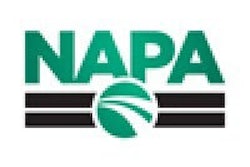The National Asphalt Pavement Association (NAPA) announced today that J.D. Ramming Paving Co. LLC of Austin, Texas, won the 2012 Ray E. Brown Airport Pavement Award for excellence in the construction of an asphalt airport pavement. The company received the award today, Feb. 13, at a ceremony during the association’s 58th Annual Meeting in Scottsdale, Ariz.
The Ray E. Brown Airport Pavement Award is presented each year to the highest-rated airport project submitted for NAPA’s Quality in Construction Awards, which recognize asphalt pavements of excellence. The award is named for Ray Brown, who served for many years as director of the National Center for Asphalt Technology at Auburn University.
“NAPA selects the recipients of its paving awards using a known set of best practices and standards known to yield high-quality asphalt pavements,” stated Kurt Bechthold, 2012 Chairman of the NAPA Board of Directors. “This award demonstrates the high quality of work J.D. Ramming Paving Co. is achieving.”
J.D. Ramming Paving Co.’s award-wining project was the overlay of Runway 13/31 at the new Austin Executive Airport, a general aviation airport that serves corporate traffic. Runway 13/31, the primary runway at the airport, had been paved by another contractor in 2009, but movement in the subgrade due to soil problems caused bumps and roughness to develop in the pavement before the airport even opened.
Once the underlying problems were resolved, J.D. Ramming Paving Co. came in to provide the smooth runway surface that the airport needed to meet its opening date. The company took a partnering approach to ensure that the owner would get the runway that it needed.
“The airport originally specified an asphalt mix used by the City of Austin, but we went into the pre-pave meeting and explained how Texas DOT (TxDOT) partners with contractors on its projects. We wanted to use a TxDOT mix that used QC/QA specifications,” said Ted Whited, Quality Control Manager for J.D. Ramming Paving Co. “The advantage to this type of mix is that the owner actually has a technician at the plant, testing side by side with our lab technicians while the material is being produced and placed. That way, if any mixes don’t meet the tolerances, we can immediately make adjustments to make sure the mix remains in spec.”
After airport managers agreed to the change, J.D. Ramming Paving Co. cleaned up the existing asphalt to prepare it for the overlay.
“There were a lot of humps and bumps in the asphalt, so we had our milling subcontractor put skis on the milling machine to make sure we had a very smooth plane,” said David Fuller, Vice President of Field Operations for J.D. Ramming Paving Co. “Standard skis are typically 40 feet, but we ran longer, 50-foot sections to ensure we got the smoothness we wanted.”
J.D. Ramming Paving Co. also used the 50-foot skis on the paver as it placed the 2-inch asphalt overlay. It produced a runway that was smooth and attractive, and greatly improved ride quality. “Before paving, the International Roughness Index (IRI) results were in the high 80s with several sections over 110. After we milled and paved the average IRI was in the low 40s,” said Chuck Fuller, President of J. D. Ramming Paving Co. Airport managers were pleased with the results, and they were able to open the airport as planned in May 2011.
“With an airport, it’s not very easy to go back and do it again. You want to make sure once you’re open that the asphalt is right the first time. You can’t close the lane down and land on the other side of the runway,” said Andrew Perry, Austin Executive Airport Executive Director. “J.D. Ramming Paving did a great job. They got in there and did the work quickly, and the overall smoothness that they got out of it was top-notch.”
The quality of the runway was independently verified a year later, when the Circuit of The Americas Formula 1 racetrack in Austin hosted the United States Grand Prix in November 2012. Before wealthy F1 racing fans from around the world risked landing their jets at Austin Executive Airport, they hired a firm to test the pavement’s smoothness. The runway passed with flying colors, and many private planes used the airport for the event.
“Partnering made the difference on this job,” said Chuck Fuller. “Everybody was out there for the same reason: We wanted a good-quality product, and we wanted everyone to go home safely. We worked together for each other,” he said.

















